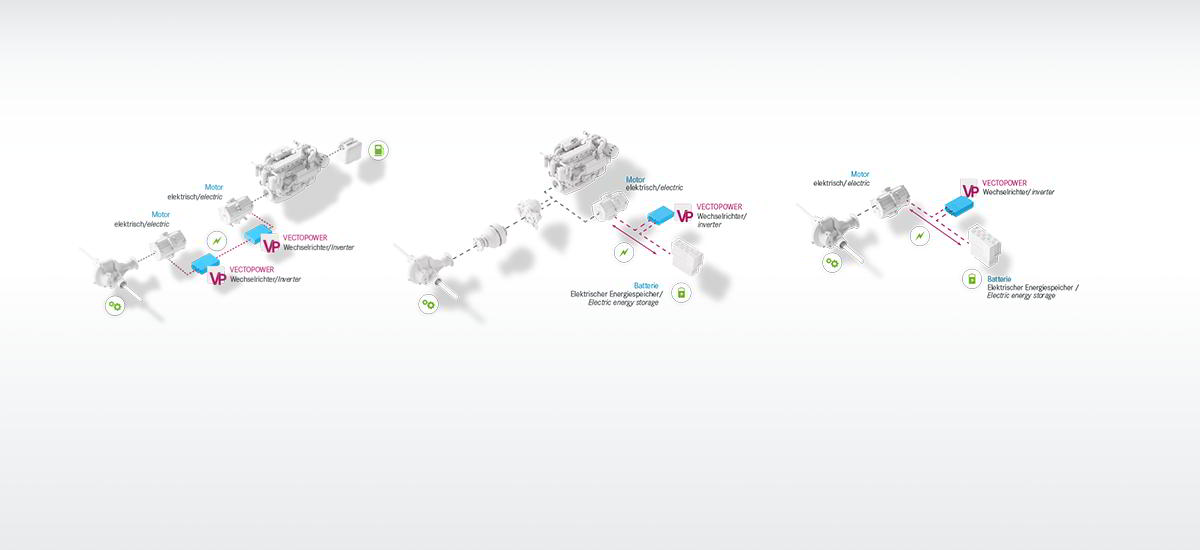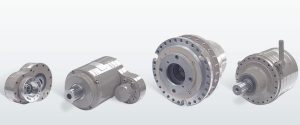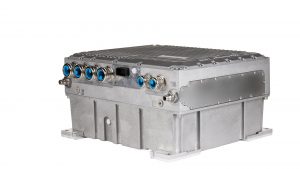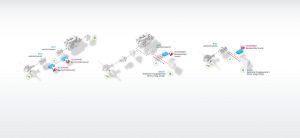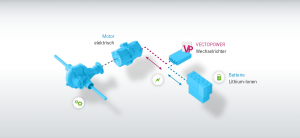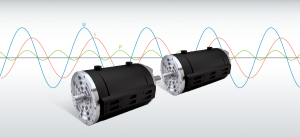There are various possibilities for electrifying a drive train. In the following, the structure, application areas, as well as the advantages and disadvantages of different electric drive types are compared.
Hybrid drives
A hybrid drive train is a combination of an electric drive and a classic drive. It therefore comprises a generator with a combustion engine as well as one or more electric motors with corresponding power electronics (e.g., VECTOPOWER from ARADEX) and an electrical energy store, typically a battery.
There are different design forms for hybrid drives: In parallel hybrid systems, a combustion engine also directly supplies the traction drive with energy, but in serial hybrid systems, it is mechanically decoupled and thus only serves as a generator for charging the battery. A distinction is also made between autonomous and plug-in hybrids. In the case of an autonomous hybrid drive, the batteries are exclusively charged via generators, while a plug-in hybrid can also be charged at a wall outlet.
The high efficiency of electric motors in partial-load operation (parallel) or the use of a combustion engine as a generator (serial) makes it possible to maximize the working time of a combustion engine at the most efficient operating point, which improves the efficiency of the entire system up to 30%.
A disadvantage of hybrid drive systems can be the complex technology that re-sults from the combination of two drive systems.
Hybrid drive trains are especially suited to applications with a greatly fluctuating load profile. The electric drive makes it possible to benefit from the many accel-eration and braking processes in urban traffic, while the combustion engine al-lows longer ranges and independence from the electrical charging infrastructure.
Diesel-electric drives
As with a hybrid drive, a diesel-electric drive is also a combination of an electric and a classic diesel drive. The difference is that diesel-electric drives do not nor-mally have an electric energy store. They consist of one or more generators with a combustion engine and usually several electric motors. The mechanical energy of the combustion engines is converted to alternating current by generators. This is ultimately converted by the corresponding power electronics (e.g., VECTOPOWER from ARADEX) into an alternating current that can be adapted in frequency and amplitude. This allows the electric motors to be operated with the appropriate speed for each situation.
The main advantage is that the mechanical motion does not have to be diverted and distributed to the respective drives in complex ways. This yields efficiency advantages in applications where there are several drives with different perfor-mance demands. Since the current frequency can be adjusted by the inverter to the respective load situation and individual combustion engines can be switched off as needed, the optimum operating point can be utilized well. This results in fuel savings of up to 20-30% compared to conventional diesel drives. I
n addition to the complex technology resulting from the combination of two sys-tems, a further disadvantage is the inability to utilize braking energy (unless a battery is also integrated in the drive train).
Diesel-electric drives are often used in large applications such as locomotives, ships, or very large off-road vehicles such as dump trucks with varying load re-quirements.
Fully electric drives
If only electric motors are used, then the drive train is fully electric. A purely elec-tric drive train has one or more electric motors that are supplied with energy from an electric energy store (preferably a battery). In addition, corresponding power electronics convert the output voltage of the battery to alternating voltage, adapt the voltage according to the requirements of the situation, and always supply the motor with the optimum current and voltage strength.
Fully electrified drives have a very high efficiency, especially in the partial-load operational range. In combination with innovative, well adapted power electronics (e.g., VECTOPOWER from ARADEX), efficiencies of over 95% can be achieved. Furthermore, electric drives do not cause any CO2 emissions during driving – making them not only efficient and low-noise but environmentally friendly as well. In addition, the technology is comparatively simple and requires much less maintenance than drives with combustion engines. A further advantage is the regenerative capability, in other words, the use of the braking energy.
There is still potential for expanding the charging infrastructure, which is not yet available everywhere, as well as for further improving battery technology – the desire for more compact batteries that allow longer ranges without causing higher purchasing costs will likely shape the developments of the next few years.
Despite all of this, fully electric drives already offer excellent possibilities for ap-plications with a fluctuating load profile and many braking and acceleration pro-cesses. Above all in urban areas (e.g., delivery trucks and public buses), the re-generative technology and the high efficiency of electric motors in the partial-load operational range allow electric vehicles to be designed for all-day use without having to be charged at an external energy source in the meantime.
Finding the right electrification variant
It is not possible to generally define the best option for electrifying a drive train. The answer to this question depends on several criteria and the application. An important influencing factor is above all the load profile of the application, alt-hough the purpose, installation space, and costs can also be basic criteria.
However, for all applications, having the best possible drive train design is a basic prerequisite for a powerful and efficient drive. As a system supplier, ARADEX not only offers application-specific advice and detailed analyses of the electrification variants for a particular application but can also completely plan and implement the electrification for all three electrification variants. For our cus-tomers, this means:
- Good performance of the application: Innovative components and a clever system design are the basis for a well performing overall system.
- Cost savings: An intelligent drive train synthesis makes it possible to eliminate a gearbox as an additional component. In addition, the battery capacity is used so efficiently that the battery can have relatively small di-mensions without reducing the range.
- We take care of it: Thanks to extensive experience, a wide product and service portfolio, as well as a strong partner network, ARADEX offers comprehensive products and services for electrification. This allows fast market readiness and frees customers for other tasks.
Naturally, ARADEX has already completed successful reference projects for all three electrification variants.
